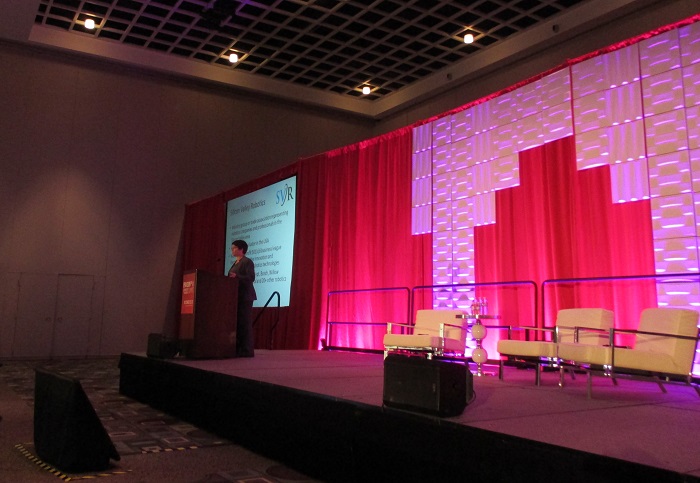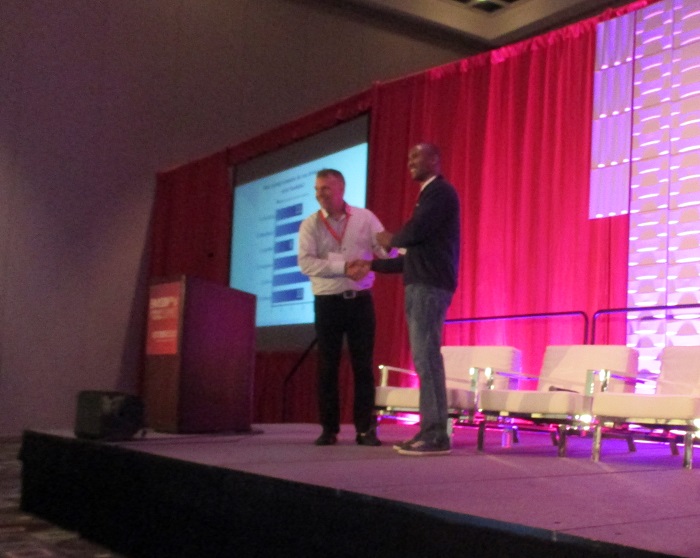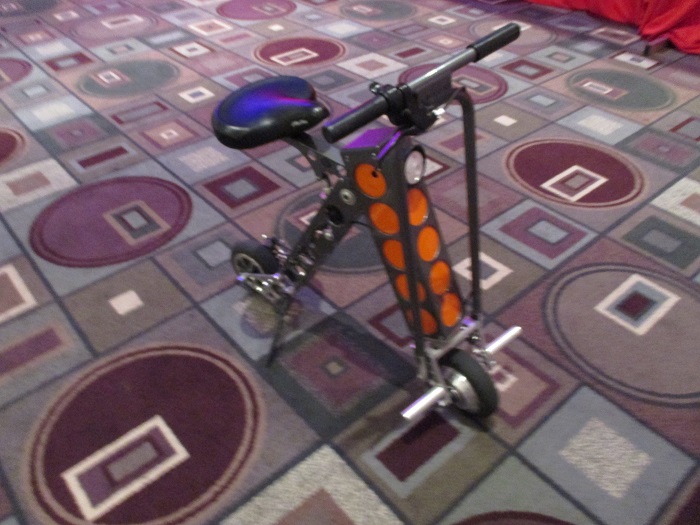by Dot Cannon 
One of the world’s most influential women received a standing ovation.
A competition for “Most Disruptive Technology” ended in a tie.
And the day’s main theme, was a more people-friendly future.
Innovate Pasadena’s inaugural ENVISION Summit hosted a full day of presentations on Thursday at the Pasadena Convention Center. Speaker sessions were interspersed with interviews and five-minute “fast pitches” from startup companies.
Dr. Patricia Moore, president of Moore Design Associates, delivered a thought-provoking and moving presentation on “Inclusive Design” in the 10:30 session. “The purpose of design is to make each of us feel welcome over the course of our lives,” she said.
Displaying her recent work on the Honolulu Light Rail system, Dr. Moore said that she had worked with organically blind consultants to design the ticketing system, and with consultants in wheelchairs to design the trains themselves.
Dr. Moore also referenced her work with the Wounded Warrior project by showing a slide of the new gym she’d designed for hospitals and health centers. “It’s in the form of a little village,” she said, pointing out the everyday objects that enable the users to exercise in nontraditional ways. “So many of the soldiers are loving (to work on the car). They don’t know they’re doing therapy.”
As an internationally-renowned gerontologist, Dr. Moore challenged her audience to come up with ways an aging population can continue to live independently. “We do not have enough mechanisms in place to care for us after the age of 85, which seems to be the tipping point,” she said.
Dr. Moore has a unique first-hand understanding of the challenges of living as an octogenarian. In a landmark experiment from 1979 to 1982, she used prosthetics and makeup to transform herself from a woman in her late twenties to a senior citizen in her eighties. The obstacles she experienced, portraying nine different senior women, led to her pioneering work in industrial design and gerontology.
At the conclusion of her talk, Dr. Moore brought her audience to their feet, as she shared the ways in which design is currently failing senior citizens. She told her listeners that she had felt like a failure–as a daughter and a designer–when she had to give her own mother a health-monitoring device.
“I saw her tears as I hung that on her neck, and that’s not design,” she said, her voice breaking.
When the applause subsided and Dr. Oren Goldschmidt took the stage, he continued the discussion with his presentation on “Innovating in the Analytics Gap”.
Goldschmidt, who is the Chief Technology Officer of Frost Data Capital, outlined some of the changes he foresees in the future. “The way we use data today has three major failings,” he said.
Goldschmidt cited those problems as being “tunnel vision”, along with inconsistency and naivete. As an example, he said, drug trials will succeed or fail based on random factors, as opposed to real facts. However, he said, the successful application of data to problems “at the top of the pyramid”, such as weather systems, indicates progress towards overcoming those flaws.
After Goldschmidt’s presentation, both he and Moore joined in an interview discussion with Dr. Linda Malkas, Deputy Director of Basic Research at City of Hope Cancer Center. A lively discussion of both design and analytics followed. Asked what project they were currently doing that each found exciting, Goldschmidt replied, “Remote monitoring.” Moore said she was working with the food industry on a smart interface “between what’s in your fridge and how it’s doled out.”
Next, it was time for fast-pitch presentations. Each of six startups had five minutes to make a pitch to the audience, who would text their votes for “Most Fundable” and “Most Disruptive Technology.” The winners, announced at the end of the day, would receive funding and a mentoring session, respectively.
After the lunch break, the topic was robots.
In his presentation, Geppetto Avatars co-founder Mark Meadows discussed the emerging field of social robots. Meadows demonstrated “Sophie”, a virtual nurse with artificial intelligence. The platform is designed to respond to a patient by sensing emotion through tone of voice and body language.
“”By 2050, sixteen percent of the population will be over sixty-five,” Meadows said,. “A robot can provide privacy, as well as invading (it).”
Next, Silicon Valley Robotics Managing Director Andra Keay took the stage to discuss “How to Talk to Your House.”
“I believe your next household robot is actually your house,” she said. “When we have something thinking and making a decision it doesn’t have to be in the same cloud.”
Keay discussed the growing areas of robotics, including agriculture. “Agricultural robots are starting to create a system that provides individualized care to each animal,” she said. “Gates open and close automatically. If the cows are a little uncomfortable, they can go and get milked now. Milk yields are going up, stress levels in the cows are going down…I’m told the farmers are happy too.”
At breaks, people networked, discussed ideas and sipped coffee.
ENVISION Chair Mark Breitenberg, who was serving as the event’s master of ceremonies, was having fun. “My biggest fear was how the different speakers would gel,” he said. We had an idea of having someone come up and interview (the two speakers from each session afterwards). None of the interviewers had ever met any of the speakers, and what’s been just stunning is that they all come out here like they’re professional talk-show hosts.”
Breitenberg said that, in fact, some of the attendees told him they’d enjoyed the spontaneous dialogues better than the presentations. “To me that’s been one of the great takeaways of the event.”
More great takeaways were coming.
The day’s final session was a panel presentation on “The Changing Landscape of Funding Your Start-up”, featuring six venture capitalists.
Discussing the dynamics of getting funded, the panelists emphasized originality and product traction. They also asked the audience to think carefully about getting start-up funding. “When you raise outside funding, it changes the entire dynamic of your business,” commented Dana Settle, of Greycroft Founding Partners.
Dale Okuno, of Pasadena Angeles, Inc., agreed. “We ‘re asking you (to report on what you’re doing) every week.” Mark Holdsworth, of Tennenbaum Capital Partners, sounded a cautionary note: “Don’t overnegotiate, if someone wants to give you money.”
The panelists said that, when they considering funding startups, they had to see something concrete.
“We’re looking for the company to have a product,” said Greg Cohn of Ad Hoc Labs.
“We won’t do anything with preproduct,” said Eric Manlunas of Wavemaker Partners. “At the very least, thirty-five to seventy thousand dollars of monthly revenue (is what we’re looking for).”
“Don’t do a ‘me too’,” advised Okuno. “Try to innovate. Or you’re just following the tail winds of somebody, and it’s hard to get above the noise.”
Later in the presentation, Okuno also offered advice on getting some coaching.
“Go to the Pasadena Angels website, see who you know and ask if they’ll help you. Go to lunch with that person, and ask their opinion on your idea. That’ll help you start getting your act together.”
The day ended with six entrepreneurs who definitely had theirs together. The only question was: which of these startups would win the “Fast Pitch” competition?
Grant Delgatty’s “Urb-E” compact electric scooter won the “Most Fundable” competition. This is a collapsible scooter that travels at about twenty mph and can be taken on a bus or train.
But, for the category of “Most Disruptive Technology”, attendees had a more difficult time deciding.
Dr. Stephen J. McCormack’s Velasense Visual Assist System allows visually impaired users to recognize colors and objects just by pointing their phones.
Mari Bower’s Kitterly Project Match matches crafters with projects according to their interests, provides kits with all the materials necessary for the project, and connects crafters with staffers who can guide them if they get stuck.
Each received an equal amount of votes–so both won.
Just before the day concluded with a cocktail reception, Breitenberg issued an invitation in his closing remarks. “Get involved,” he said. “We want to make ENVISION 2015 much more interactive next year.”
See you in 2015, ENVISION–and hopefully, in 2034 as well.
(Like to know more about nonprofit Innovate Pasadena and their upcoming events? They’re looking for local organizations and individual innovators to get involved. You can find out more about these opportunities, and about their volunteer needs, on their website.)















